Abstract
The Shiquanhe–Laguoco–Yongzhu–Jiali ophiolite mélange belt in Tibet includes the Laguoco Tso ophiolite as part of its western segment. Researchers studying the evolution of the Tibetan Plateau and the Tethys have taken a keen interest in the debated relationship between this ophiolite belt and the Bangong–Nujiang ophiolite belt. However, there is little research in this field. This study reports the rock geochemistry, SIMS (the secondary ion mass spectrometry) zircon U-Pb ages, and O isotope compositions of gabbro from the Laguoco ophiolite. Gabbro has substantial depletion in HFSEs (the high field strength elements) such as Th, Nb, Zr, and Hf, as well as exhibits comparatively high Mg# (80.6 on average), and low K, N, P, and Ti contents. Therefore, it was possibly formed in an intra oceanic subduction island arc environment originating from ~30% partial melting of the depleted spinel lherzolite. The SIMS zircon U-Pb ages of the gabbro samples are 187 ± 1.2 Ma and 189 ± 2.1 Ma, and the weighted averages of δ18O are 5.24‰ ± 0.12‰ and 5.34‰ ± 0.13‰, which are close to mantle-derived zircon δ18O (5.3‰ ± 0.3‰). These results suggest that during the Early Jurassic, the Laguoco ophiolite recorded the intra oceanic subduction of the northern branch of the Neo-Tethys.
1. Introduction
Ophiolites are commonly thought to be remnants of the paleo-oceanic lithosphere and a crucial rock assemblage among those studying the history of paleo-oceanic tectonics and magmatic evolution [1,2,3]. As recorders of the formation, convergence, and closure of paleo-oceans that offer critical evidence for studying magmatic evolution and melt–rock reaction in the oceanic lithosphere’s upper mantle, they are extensively employed in plate tectonic system investigations [4,5,6].
The Shiquanhe–Laguoco–Yongzhu–Jiali ophiolite mélange belt (abbreviated as “SLYJZ”) in the central Tibetan plateau is located in the northern part of the Yarlung– Zangbo suture zone, near the southern part of the Bangong–Nujiang suture zone (Figure 1) [7,8]. The NWW–EW–SE-trending belt starts from the Shiquanhe River in the west and runs southeastward past Guchang, Laguoco, Asuo, Shenzha, Yongzhu, and Kaimeng, over a distance of more than a thousand kilometers with a width of 3km–35 km [6,9,10]. The ophiolite’s petrogenesis in this belt and the associated sedimentary rock formations have been widely investigated since the 1990s [10,11]. Particularly, as geological mapping efforts of the Tibetan plateau roll out, novel insights into the distribution, rock composition, formation age, and tectonic background of the ophiolite are gained. However, the ophiolite’s origin and the tectonic affiliation of this belt remain undetermined, restraining further understanding of critical geological aspects of the Tibetan plateau. The ophiolite’s formation environment (intraplate, oceanic island, forearc/back arc basin, or supra subduction zone), subduction polarity (southward or northward), ocean opening mechanism, and opening/closing time (the oceanic crust began to form in the Late Triassic, subducted in the Early to Middle Jurassic; the oceanic basin remained open until the Early Cretaceous) remains debatable [9,12,13,14,15,16,17,18,19]. Thus, more work is required to define the precise tectonic evolution of the SLYJZ suture zone.
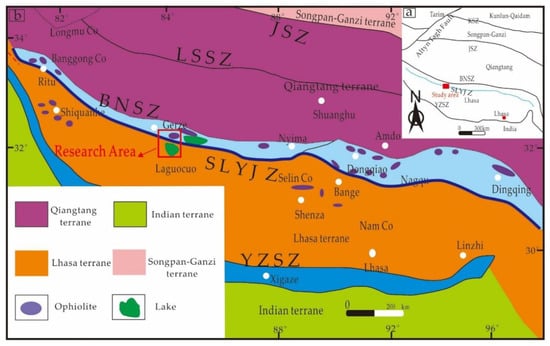
Figure 1.
(a) The main geotectonic units of eastern Asia. (b) The simplified geotectonic map of the Tibetan Plateau from the Shiquanhe–Laguoco–Yongzhu–Jiali zone was modified after [12]. KSZ: the Kunlun–Qaidam suture zone, JSZ: the Jinsha suture zone, LSSZ: the Longmuco–Shuanghu suture zone, BNSZ: the Bangong–Nujiang suture zone, YZSZ: the Yarlung–Zangbo suture zone.
Fan Shuaquan et al. [20] argued that the SLYJZ suture zone formed in a supra subduction zone tectonic environment and is an SSZ-type (the supra subduction zone) ophiolite. Previous investigations have dated the Laguoco Tso ophiolite to the Jurassic–Early Cretaceous on the following basis: (1) Regarding the age of the Laguoco Tso ophiolite, the disagreement relates to whether it originated in the Middle Jurassic or Early Cretaceous. For gabbro in the Laguoco Tso ophiolite, the Ar-Ar age is 125 Ma; further, the zircon ages are 155.3 ± 2.6 Ma and 166.6 ± 2.5 Ma, whereas the zircon ages for plagiogranite in the related ophiolite are 155.3 ± 2.6 Ma, 166.6 ± 2.5 Ma, and 190 Ma [14,21,22,23], showing that the Laguoco Tso oceanic basin was primarily formed in the Middle Jurassic. (2) Regarding the Laguoco Tso ophiolite’s highly controversial tectonic background, Wang Baodi et al. [22] propose that it was produced in an inter arc basin. Regarding its tectonic background, opinions include a back arc basin, a mid-oceanic ridge, and intra oceanic subduction. Therefore, probing deeper into the Laguoco Tso ophiolite is crucial for debates over the Laguoco Tso ophiolite’s tectonic evolution in the SLYJZ suture zone.
Based on past findings and field activities, this study comprises comprehensive petrological, geochemical, and chronological research on gabbro, incorporating zircon O isotope analysis to allow further examination of the petrogenesis. In addition, evolutionary history of the ophiolite as well as valuable information for a better understanding of regional tectonics and evolution are provided.
2. Geological Overview and Geological Characteristics of Laguoco Ophiolite
The study area is located at the central Tibetan Plateau, about 30 km south of Gerze county, tectonically along the north bank of the Laguoco ophiolite on the southern boundary of the western SLYJZ suture zone (Figure 2). It occurs E-W in an irregular lenticular form, extending ~30 km by 3–5 km width, with an exposed area of ~120 km2, connected to the Guchang ophiolite mélange belt to the west. The Laguoco Tso ophiolite is on the north bank of Laguoco Lake, where plate tectonic processes have dismembered the rock body. The Laguoco Tso ophiolite is in fault contact with the Lower Cretaceous Langshan formation (K1l) marine limestone as structural emplacements. The Early Permian Lower Xiala formation (P1x), whose dominant lithology is grayish white dolomite and purplish red bioclastic limestone, is in contact with the south side. It is in fault contact with Late Jurassic to the Early Cretaceous Zelong group (J3K1z) volcanic rocks, whose lithologies are mainly composed of particolored sandstone, andesitic volcanic breccia, rhyolitic dacite, and a lesser amount of microcrystal limestone. The north side of the area is bounded using dextral strike-slip structures with the fault plane dipping 45°–60° N. The ophiolite is overthrust by the Late Carboniferous to Early Permian Laga formation (C2P1l) within the belt, which comprises grayish green quartz sandstone, gravelly sandstone, siltstone, and shale. Early Cretaceous Duoni formation (K1d) volcanic rocks comprise a series of sporadically distributed, intermediate acidic volcanic rocks, mainly andesite and rhyolite (Figure 2).
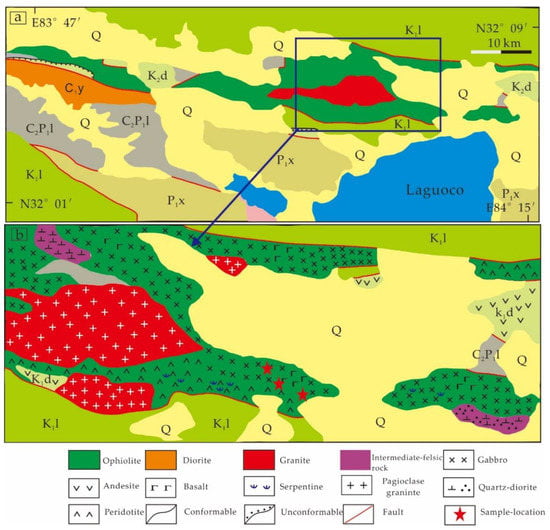
Figure 2.
(a) Main geotectonic units of Laguoco. (b) Simplified geologic map of the Laguoco ophiolite, modified after [12]. C1y: Early Carboniferous Yongzhu formation; C2P1l: Late Carboniferous–Early Permian Laga Formation; P1x: Early Permian Xiala Formation; K1l: Early Cretaceous Lanon Formation; K1d: Early Cretaceous Duoni Formation; Q: Quaternary.
According to a geological field survey, the Laguoco Tso ophiolite is severely fractured through tectonic processes. With Early Cretaceous (K1l) limestone blocks present in the basic rocks, the ophiolite has almost all compositional units, such as mantle peridotite, cumulate, pillow lava, diabase, plagiogranite, and silicalite. Primary rocks in the mantle peridotite include serpentinite, dunnite, lherzolite, and harzburgite, most of which have been intensely serpentinite. The rocks commonly feature a reticular texture and a massive structure.
Cumulates are sporadically seen and frequently overburdened by Quaternary in the study area. The cumulate is mainly a series of cumulate gabbro comprised of homogeneous gabbro and a lesser amount of stratiform gabbro. The latter has a typical cumulate texture including various types of rhythmic layers commonly 1 cm–2 cm thick with quasi-stratification. The former features a massive structure. The pillow basalt is primarily discovered on the Laguoco Tso Lake’s north bank, showing a typical pillow structure. Therefore, the pillow basalt is commonly quite fractured in late tectonic processes, but the pillow shape is still discernible. These grayish green rocks feature porphyritic texture and pillow structure. The phenocryst mainly comprises plagioclase. Many of the rocks contain pore structures that are irregularly shaped and filled with late calcite, chlorite, quartz, and other minerals. The diabase dykes differ in width, commonly between 10 cm and 15 cm, and stretch 50 m to 200 m in length. Mostly these typically grayish green rocks feature grayish green texture and massive structure. Mostly plagiogranite exists in basic rocks as irregular gray dykes. Generally, the dykes are 3 cm–60 cm across, lying in intrusive contact with the surrounding rock, and feature granular texture and massive structure. Several of the dykes have been chloritized to differing degrees in later years. The silicalite is mainly purplish red. Most of these rocks feature a cryptocrystalline texture and massive structure. They lie primarily in structural contact with basic rocks and are widely distributed in the study area (Figure 3a–f).

Figure 3.
(a–f) Field photographs of the Laguoco ophiolite. (a) Serpentinzed peridotite; (b) Isotropic gabbro; (c) Diabase dyke; (d) Pillow basalt;(e) Plagioclase granite; (f) Overlying radiolarian chert from Laguoco.
3. Analytical Methods
3.1. Petrographic Analysis
The most abundant rocks in the Laguoco Tso ophiolite are gabbro. Under both field and microscopic analysis, the cumulate gabbro among them appears to be cumulated. These grayish green rocks (Figure 4) feature intermediate fine-grained texture and massive structure. The minerals are mainly plagioclase, pyroxene, amphibole, and low amounts of olivine and chromite. The plagioclase occurs as idiomorphic and hypidiomorphic long columns with a grain size of 0.02 mm–0.05 mm. The rocks are partially chloritized or epidotized. Pyroxene occurs as hypidiomorphic or xenomorphic grains with a grain size of 0.02 mm–0.05 mm.
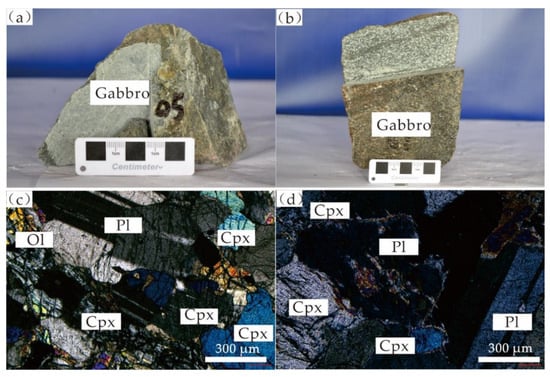
Figure 4.
Photomicrographs of the Laguoco Gabbro. (a,b) The gabbro hand specimen; (c,d) Isotropic gabbro with gabbro and ophitic textures. Cpx: clinopyroxene; Ol: olivine; and Pl: plagioclase.
3.2. Whole-Rock Major and Trace Element Geochemistry
Seven gabbro samples were analyzed for major and trace elements at the National Research Center for Geo-analysis in Beijing, China. Samples were trimmed to remove the oxidized surfaces, cleaned in deionized water, and were then crushed and powered to about 200 meshes within agate mills. Major elements were analyzed by X-ray fluorescence (XRF) spectrometry, with an analytical accuracy of ~1% relative to SiO2 and 2% relative to the other oxides. The major method and procedure of analysis are described by Chen et al. [24]. Trace elements, including rare elements (REE), were determined by inductively coupled mass spectrometry (ICP-MS). Analytical uncertainties were estimated to be 10% for trace elements with abundances < 10ppm. The detailed methods and procedures are described by Qi and Grégoire et al. [25]. Loss on ignition (LOI) values were determined by gravimetric techniques in which the sample was heated in a closed container and the water vapor was collected in a separate tube, condensed, and then weighed. The detection limit for H2O and CO2 was 0.01 wt %. The major and trace element compositions are given in the Table 1.

Table 1.
Whole-rock analyses of major (%) and trace element (ppm) of gabbro, Laguoco, Tibet.
3.3. SIMS zircon U-Pb Chronological Test Method
For zircon U-Pb age and O isotopes, two samples from the Laguoco Tso ophiolite (LGC04 and LGC07) were examined using SIMS. Zircon were separated using conventional gravity and magnet separation. With standard zircon Plésovice [26], the sorted zircon grains were pasted on an epoxy resin target together with Qinghu [27], then ground and polished until the zircon core was exposed. Zircon samples were subjected to transmission and reflection photomicrography, cathodoluminescence image analysis, and the zircon target preparation to confirm the morphology and internal texture of zircon and determine the most suitable test area. Finally, the sample target was gold plated in a vacuum to a thickness of ~30 nm.
SIMS zircon U-Pb age analysis was conducted at the Beijing Research Institute of Uranium Geology using a CAMECA 1280 HR SIMS. The analysis method was the same as that described by Li et al. [28]. Standard zircons and the zircon samples were measured alternately in a ratio of 1:4. The following instrument working parameters were employed: the main ion optical path system was the Kohler model; the main ion beam intensity was ~10nA; the primary mass filter aperture size was 200 μm; the main ion optical path system was modulated, so that the main ion beam spot reaching the sample surface was sized ~20 μm × 30 μm. The secondary ion optical path contrast aperture was 400 μm; the entrance slit was 80 μm; the field aperture was 7000 μm; the energy slit was 50 eV; the exit slit was 173 μm; and the instrument mass resolution was ~7007 (defined by 50% peak height). Secondary ion signals were received using the electron multiplier of a monocollector system. The following signals were sequentially collected: 196 (90Zr216O), 200 (92Zr216O), 200.5, 204 (94Zr216O), 204 (204Pb), 206 (206Pb), 207 (207Pb), 208 (208Pb), 209 (177Hf16O2), 232Th, 238U, 232Th16O, 238U16O, and 238U16O2. The waiting time before signal collection was: 2.96 s, 0.80 s, 0.80 s, 0.80 s, 1.52 s, 0.80 s, 0.80 s, 0.80 s, 0.80 s, 1.20 s, 0.88 s, 0.88 s, 0.88 s, and 1.04 s. The signal collection time was: 1.04 s, 0.48 s, 4.00 s, 0.64 s, 6.08 s, 4.00 s, 6.00 s, 2.00 s, 1.04 s, 2.00 s, 2.00 s, 2.00 s, 2.00 s, and 2.00 s, respectively. Signals were collected for seven cycles, and the test lasted for ~12 min at each test point. The U-Th-Pb isotope ratios were obtained via correction against standard Plésovice (337 Ma, [26]). Correction against the standard zircon 91500 produced U contents (81 × 10−6, [26]). Single point sample errors were obtained through the standard deviation’s joint transmission, obtained by long-term standard sample monitoring (1SD = 1.5%, [28]) and the single point test’s internal accuracy; as an unknown sample, data accuracy was monitored against standard sample Qinghu (159.5 Ma, [27]). The measured 204Pb was employed for correcting ordinary Pb. The absolute majority of the ordinary Pb content measured was very low (10−6). Thus, the Pb content was corrected against the mean Pb composition of modern crust as the ordinary Pb composition, assuming that ordinary Pb primarily originates from the surface Pb contaminants brought in during sample preparation. The zircon age standard of Qinghu was used for calibration of Pb/U fractionation and monitoring the quality of unknown dating results. The data were calculated by Isoplot 4.15 [29].
3.4. SIMS Zircon O Isotope Test Method
Zircon O isotope analysis was conducted at the Beijing Research Institute of Uranium Geology using a CAMECA 1280 SIMS. The following test conditions were employed. The primary ion optical path system was a Gaussian model; the main ion aperture was sized 400 μm; the Cs+ main ion beam intensity was~2nA; the grid scan size was 20 μm; and the main ion optical path system was modulated so that the main ion beam spot reaching the sample surface was sized ~20 μm. Electrons obtained through a vertical-incidence electron gun were evenly applied within 100 μm to neutralize the charge effect of the sample surface. Secondary ions were accelerated through −10 kV voltage; the secondary ion optical path contrast aperture was 400 μm; the entrance slit was 150 μm; the field aperture was 5001 μm; the energy slit was 50 eV; the exit slit was 400 μm; and the instrument mass resolution was about 2400 (defined by 10% peak height). O isotopes were evaluated using a multi-collector. Nuclear magnetic resonance was used to stabilize the field strength. The primary standard sample for the O isotope test was the reference material Penglai zircon (δ18O = 5.31‰ ± 0.10‰), whereas the quality control standard sample was Qinghu zircon. Secondary ion signals were received through a fixed field using the multi-collector system’s Faraday cup. The 16O and 18O signals were collected. The signals were collected for 20 cycles, and the test lasted for ~4 min, including 60 s for pre-denudation and 2 min 40 s for signal collection and instrument parameter optimization at each test point. The single-point test’s internal precision was better than 0.2‰ (1σ). SIMS instrument mass fractionation (IMF) was corrected against the Penglai zircon standard. Measured 18O/16O ratios were corrected against the Vienna standard mean ocean water (V-SMOW) value (18O/16O = 0.0020052), minus the IMF, and selected as the δ18O of that point. The following was used:
(δ18O)M = ((18O/16O)M/0.0020052 − 1) × 1000(‰)
IMF = (δ18O)M(Standard) − (δ18O) V-SMOW
(δ18O)Sample = (δ18O) M − IMF
4. Test Results
4.1. Geochemical Compositions
Table 1 shows the major and trace element analysis findings of gabbro in the research area. The major elements of gabbro were discovered to contain the following: moderate SiO2 (49.57%–51.06%) content; relatively high MgO (10.98%–14.09%) and CaO (0.92%–1.09%) contents; high Mg# (78.49%–81.79%); moderate Al2O3 (13.26%–16.73%); and low TiO2 (0.15%–0.18%), Fe2O3 (1.34%–1.71%), Na2O (0.74%–1.13%), K2O (0.06%–0.13%), and P2O5 (0.005%–0.007%) contents. The gabbro samples fall in the basalt region in the TAS (the total alkali silica) discrimination diagram; all samples belong to the low potassium tholeiitic basalt series in the rock series discrimination diagram (Figure 5a,b). The gabbro samples have low contents of REEs(the rare earth elements). With an average of 3.86 × 10−6, the total REE content varies between 3.48 × 10−6 and 4.82 × 10−6. All samples appear to be flat in the chondrite-normalized REE pattern (Figure 6a), which indicates slight LREE (the light rare earth elements) depletion, with (La/Yb) N between 0.84 and 1.07, and an Eu-positive anomaly (Eu/Eu*) between 1.12 and 1.49 with an average value of 1.30. Although it is almost parallel to the N-MORB (the normal middle ocean ridge basalt) curve, its content is substantially depleted relative to N-MORB. In the primitive mantle-normalized trace element pattern (Figure 6b), gabbro is enriched with LILEs(the large ion lithophile elements) such as Rb, Ba, and Sr but depleted in HFSEs such as Th, U, Nb, and Ta, resembling the qualities of island arc basalt.
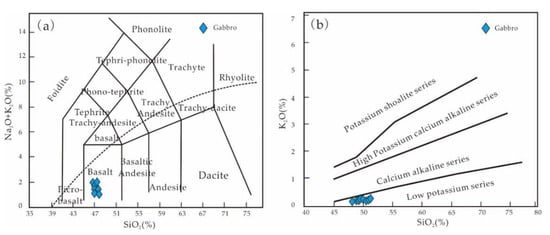
Figure 5.
TAS discrimination diagram and rock series of gabbro, Laguoco, Tibet: (a) TAS discrimination diagram of samples modified after [30]; (b) discrimination diagram of rock series modified after [31].
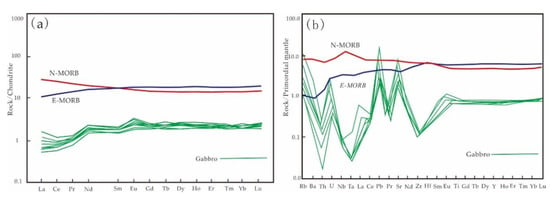
Figure 6.
(a,b) Chondrite-normalized REE and primitive mantle-normalized trace element distribution patterns for gabbro, Laguoco, Tibet, modified after [33].
The gabbro samples generally exhibit an Eu-positive anomaly and similar REE distribution patterns, indicating that they have the same petrogenesis. In addition, the primitive mantle-normalized trace element pattern demonstrates very similar distribution curves: enrichment of LILEs such as Tb, Ba, and Sr, extreme depletion of HFSEs such as Th, U, Nb, and Ta, and substantial depletion of Zr, Ti, and Nb relative to E-MORB(the enrich middle ocean ridge basalt), possibly an indication of subduction processes [32]. These geochemical characteristics show that the Laguoco Tso ophiolite samples have the characteristics of an SSZ-type ophiolite.
4.2. SIMS Zircon U-Pb Dating Results
The zircon grains of gabbro samples LGC04 and LGC07 are mostly 100–150 μm in diameter (Figure 7b,d). A few fissures and inclusions can be seen inside the zircons, which are primarily found as long columns or grains with an aspect ratio of 1~2. CL photographs show magmatic oscillatory zoning in zircons, proposing a magmatic origin [33,34].
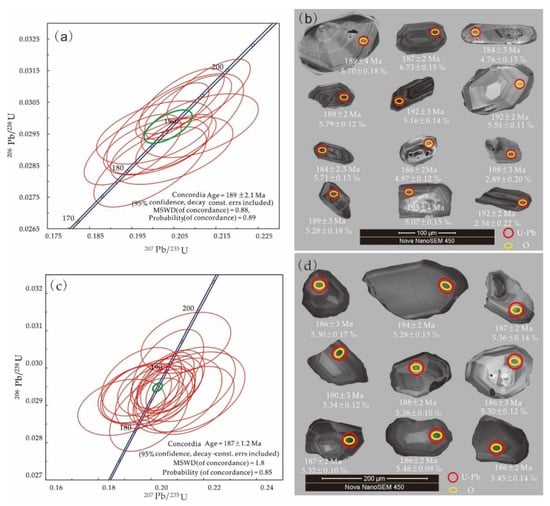
Figure 7.
Representative cathodoluminescence (CL) images (b,d) and Concordia diagrams (a,c) of zircons in the Laguoco gabbro. Red and yellow circles show the locations of U-Pb dating and O isotope analyses with SIMS, respectively.
Studies have shown that magmatic zircons have large Th/U ratios (generally > 0.4), and, for zircons, Th is directly proportional to U [34,35]. From Table 2, for the 23 test points of sample LGC04, the U content is 369–2093 μg/g; the Th content is 174–792 μg/g; and the Th/U ratio is 0.5–1.4. Th and U values were consistent, indicating a magmatic origin. For the 23 test points of sample LGC04, the zircon Concordia age is 189 ± 2.1 Ma (Figure 7a), denoting the crystallization age of the gabbro. For the 12 test points of sample LGC07, the U content is 365–2285 μg/g; the Th content is 207–2044 μg/g; and the Th/U ratio is 0.4–1.2. Th and U are consistent, indicating a magmatic origin. For the 12 test points of sample LGC07, the zircon Concordia age is 187 ± 1.2 Ma (Figure 7c), denoting the crystallization age of the gabbro.

Table 2.
SIMS zircon U-Pb data of gabbro, Laguoco, Tibet.
4.3. SIMS Zircon O Isotope Results
Gabbro samples LGC04 and LGC07 from the Laguoco Tso ophiolite were examined using SIMS for zircon O isotopes that were evaluated at the same location as the U-Pb test points. Table 3 lists the test findings.

Table 3.
SIMS zircon O data of gabbro, Laguoco, Tibet.
For zircons of gabbro sample LGC04, the δ18O is 2.89‰–6.73‰. Except for test point 2, which has a comparatively high δ18O of 6.73‰, the weighted average of the remaining points is 5.24‰ ± 0.12‰ (Figure 8a), which is the same as mantle δ18O (5.3‰ ± 0.3‰, [34,35]). For zircons of diabase sample LGC07, the δ18O is 5.15‰–5.48‰. The weighted average of all points is 5.34‰ ± 0.12‰ (Figure 8b), which is the same as mantle δ18O (5.3‰ ± 0.3‰, [36]), proposing that this group of zircons originates from mantle-derived crystallization.
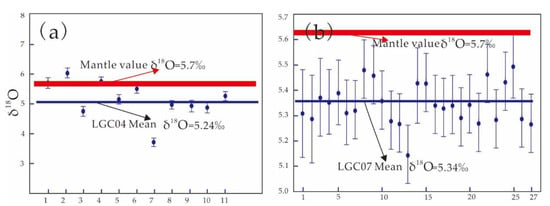
Figure 8.
(a,b) The SIMS oxygen isotope results of gabbro.
5. Discussion
5.1. Petrogenesis
The whole-rock element geochemistry of fundamental rocks can be used to inverse the characteristics of alternative mantle sources. HFSEs (Nb, Ta, Zr, Hf, and Th) and HREEs can resist late hydrothermal changes [37,38,39,40]. The gabbro is abundant in LILEs Rb, Ba, and Sr and depleted in HFSEs Nb, Ta, and Zr (Figure 6b), indicating possible exposure to subduction plate materials during formation.
High Sr/Nd ratios are generally attributed to subducted plate fluids, whereas high Th/Yb ratios are attributed to the addition of subduction sediments [41,42]. Gabbro samples in this study had significantly higher Sr/Nd ratios (139 and 214) than the corresponding values for mid-oceanic ridge basalt (12.33, [33]) and upper crust (11.85, [33]). The gabbro is very depleted in Th, Nb, and Ta (the test content of the sample is lower than the detection limit of the instrument<0.05), with the Th/Yb ratio lower than E-MORB (0.25, [33]). Thus, these HFSE ratios indicate exposure to subduction fluids during formation, whereas subduction sediment melts do not play a significant role. The ratios of the inactive elements Dy/Yb, La/Yb, and Sm/Yb to Sm indicate the compositional characteristics of rock sources [39,40,43]. For the gabbro in Laguoco Tso ophiolite, Dy/Yb-La/Yb (Figure 9a), the relatively high Dy/Yb (1.55 on average) and relatively low La/Yb (0.46 on average) indicate that the source originates from a high degree of partially melted, spinel lherzolite mantle. Sm/Yb-Sm (Figure 9b) shows that the source magma originates from the partial melting of spinel lherzolite, both pointing to a depleted source.
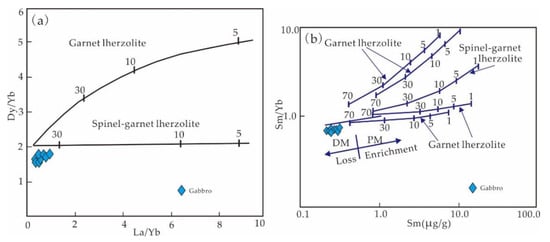
Figure 9.
(a,b) Source characteristics of gabbro rock, Laguoco, Tibet, modified after [39,40].
5.2. Formation Age and Geological Significance
The radiolarian silicalite of the silicalite in the Laguoco Tso ophiolite formed in J2–K1 [44], consistent with the zircon age of basic rocks (183–165 Ma) [14] and the zircon age of plagioclase (189–166 Ma) [45,46]. Fundamental rocks commonly had geochemical qualities of an island arc; these ages can denote the subduction time of the oceanic basin. According to the previously published age data for the SLYJZ ophiolite mélange belt (Figure 10), the Kaimeng ophiolite in the east segment formed in the Late Triassic (the zircon age of peridotite is 218 ± 4 Ma [47]); the Nam Co ophiolite in the middle segment formed in the Early Jurassic (the zircon age of gabbro is 178 ± 2.9 Ma [34]; the Rb-Sr age of harzburgite is 166 ± 26 Ma [15]); the Yongzhu ophiolite formed in the Early Jurassic to Early Cretaceous (the zircon age of basic rocks is 178–114 Ma [18,48]; the zircon age of the quartz in the Aso structural mélange belt is 123 Ma [49]).The Laguoco Tso ophiolite in the west segment was formed between the Middle Jurassic and Early Cretaceous (the zircon age of plagiogranite is 189–166 Ma [14,22]; the zircon age of the gabbro is 183.5 ± 2.2 Ma [45]; the diabase’s zircon age is 165 ± 3.5 Ma [46]; the Ar-Ar age of amphibolite is 150–137 Ma [46]); the Guchang ophiolite formed in the Early Cretaceous (the age of amphiboles in the gabbro is 128 ± 2.6 Ma [50]); and the Shiquanhe ophiolite formed in the Middle Jurassic (the zircon age of granitoids is 166–159 Ma [17,19]). Therefore, previous age investigations have confirmed that the age of ophiolites in this suture zone differs across various locations. Additionally, a mature oceanic basin in this ophiolite mélange belt has received extensive subduction processes since the Late Triassic oceanic basin had evolved until the Early Cretaceous.
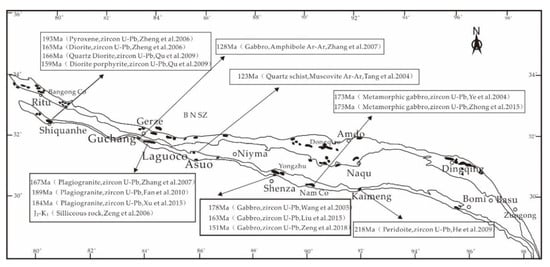
Figure 10.
The age distribution of the main ophiolite, the base map modified after [51].
As previously mentioned, the Concordia ages of gabbro samples LGC04 and LGC07 from the Laguoco Tso ophiolite are 189 ± 2.1 Ma and 187 ± 1.2 Ma, respectively. The U and Th content for the two groups of samples is ~117–679 × 10−6, and the U/Th ratio is 0.60–1.4. Given that all the internal structural characteristics in the zircon CL photographs propose that the gabbro zircons are of a magmatic origin with weighted average zircon δ18O of 5.24‰ ± 0.2‰ and 5.34‰ ± 0.2‰, agreeing with the mantle-derived zircon O isotopes (δ18O mantle-derived = 5.2‰ ± 0.3‰), it was proposed that zircons of these samples originate from mantle-derived crystallization. This age denotes the crystallization age of gabbro and the formation age of the Laguoco Tso ophiolite.
The SIMS high-accuracy zircon age yielded for the fundamental rocks falls within the 192–189 Ma interval, representing the formation time of the oceanic basin represented by the ophiolite, further providing that the Laguoco Tso ophiolite formed in the Early Jurassic. This understanding establishes that interoceanic subduction occurred in the Neo Tethys oceanic basin in the west segment of the SLYJZ ophiolite mélange belt during the Early Jurassic.
5.3. Tectonic Background
The vast majority of ophiolites in suture zones are SSZ types, which are commonly discovered in forearc basins, back arc basins, island arcs, or small oceanic basins worldwide [3]. Investigations on gabbro in various regions of the SLYJZ ophiolite mélange belt have shown that: for the ophiolite mélange in the western segment, the Shiquanhe ophiolite has the geochemical qualities of MORB, IAT,(the island arc tholelite) and OIB(the ocean island balsalt ), and it is an SSZ-type ophiolite [7,10,19,51,52]; the Guchang ophiolite has the geochemical qualities of the MORB, and it was produced in a confined small oceanic basin [49,53]; the Laguoco Tso ophiolite has the geochemical qualities of MORB and IAT and it formed in a basin, inter arc basin or island arc associated with an SSZ subduction environment [14,21,22,46]. For the ophiolite in the middle segment, the Asuo–Yongzhu–Nam Co ophiolite has the geochemical properties of MORB and IAT transition and it was produced in a back arc or inter arc basin [15,18,48,54]; the Kaimeng ophiolite in the east has the geochemical qualities of IAT and MORB [47].
The gabbro samples from the Laguoco Tso ophiolite in the research area lacked LREEs. They have a chondrite-normalized dispersion pattern similar to E-MORB (Figure 6a). However, compared to E-MORB, their overall REE and trace element levels are lower, indicating a depleted mantle source. Owing to their extreme depletion in the HFSEs, such as U, Th, Nb, and Ta, they have extremely low Th/Yb and reasonably high Zr/Nb. The gabbro samples’ TiO2 contents are quite close (0.16 and 0.17 on average) and are substantially lower than the average value for mid-oceanic ridge basalt (0.8% [41]). In the primitive mantle-normalized trace element pattern (Figure 6b), Sr appears to be positively anomalous, and Zr appears to be negatively anomalous. The V-Ti/1000 and Ti/V-Ti/Sc diagrams (Figure 11a,b) fall in the forearc environment for the Izu–Bonin–Mariana (IBM) boninite; however, they do not have a U-shaped chondrite-normalized REE pattern typical of a boninite. Additionally, for the gabbro samples from the Laguoco Tso basic rocks, the SiO2 contents are 49.57% and 51.06%, distinct from the recommended value for boninite (SiO2 > 53% [55]), exempting the feasibility of a boninite. Thus, the samples in this research formed somewhere like an island arc or forearc environment instead of being a boninite. The geochemical evolution of the gabbro is the same as the magmatic evolution in an interoceanic arc environment assumed by prior investigations. It is different from a typical mature back arc basin environment. However, it resembles an inter arc basin environment [56].
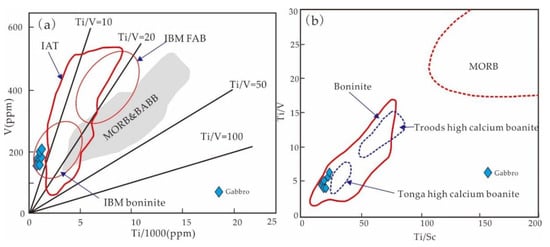
Figure 11.
(a,b) Discrimination diagrams of gabbro tectonic environment, Laguoco, Tibet, modified after [57].
6. Conclusions
- (1)
- The gabbro in the Laguoco Tso ophiolites exhibits the geochemical characteristics of island arc tholeiite (IAT). It is slightly abundant with LILEs (Rb and Ba) and extremely depleted in HFSEs (Nb, Zr, and Ba), suggesting that it was affected by subduction fluids during formation and that it is an SSZ type ophiolite.
- (2)
- A tectonic environment study of gabbro in the Laguoco Tso ophiolite shows either an island arc environment associated with interoceanic subduction or an immature forearc basin environment. The main rock in the parent magmatic source is spinel lherzolite, partially melted to a relatively high degree.
- (3)
- The SIMS zircon U-Pb isotope ages of the gabbro samples from the Laguoco Tso ophiolite are 189 ± 2.1 Ma and 187 ± 1.2 Ma; the O isotopes are 5.24‰ ± 0.2‰ and 5.34‰ ± 0.2‰, indicating feasible interoceanic subduction in this SLYJZ ophiolite mélange belt during the Early Jurassic.
Author Contributions
Y.W. contributed to write the manuscript and the sample analysis; D.-F.G., F.L., M.-K.Q., D.-F.G., J.-S.Y., G.-L.G. and W.-W.W. contributed to the conception of the study and wrote the manuscript; C.Z. performed fieldwork and data analysis. All authors have read and agreed to the published version of the manuscript.
Funding
This work was financially supported by the China Nuclear Geological Survey (DHTLM2101; CHTLM21-08), National Natural Science Foundation of China (Grant No.92062215; 41720104009), and China Geological Survey (DD20221630).
Data Availability Statement
Not applicable.
Acknowledgments
The authors acknowledge Sheng He for the SIMS test. Finally, the authors are grateful to the anonymous reviewers for improving this paper.
Conflicts of Interest
The authors declare no conflict of interest.
References
- Yin, A.; Harrison, T.M. Geologic evolution of the Himalayan-Tibetan orogen. Annu. Rev. Earth Planet. Sci. 2000, 28, 211–280. [Google Scholar] [CrossRef]
- Moores, E.M. A personal History of the ophiolite concept. Soc. Am. Spec. Pap. 2003, 373, 17–29. [Google Scholar]
- Dilek, Y.; Furnes, H. Ophiolite and their origins. Elements 2014, 10, 93–100. [Google Scholar] [CrossRef]
- Yang, J.S.; Xu, X.Z.; Rong, H.; Niu, X.L. Deep Minerals in Ophiolite Mantle Peridotites: Discovery and Progress. Bull. Mineral. Petrol. Geochem. 2013, 32, 159–170. [Google Scholar]
- Lian, D.Y.; Yang, J.S.; Liu, F.; Wu, W.W. Diamond Classification, Compositional Characteristics, and Research Progress: A Review. Earth Sci. 2019, 44, 3409–3453. [Google Scholar]
- Liu, F.; Yang, J.S.; Lian, D.Y.; Li, G.L. Geological of Neothyan ophiolite in Tibetan Plateau and its tectonic evolution. Acta Petrol. Sin. 2020, 36, 2913–2945. [Google Scholar]
- Hu, C.Z. Characteristics of Shiquanhe-Guchang Ophiolite Belt and its Geologic Significance. J. Chengdu Coll. Geol. 1990, 17, 23–30. [Google Scholar]
- Wang, B.D.; Liu, H.; Wang, L.Q.; He, J.; Wang, D.; Li, F.Q. Spatial-Temporal framework of Shiquanhe-laguoco-Yongzhu-Jiali ophiolite mélange zone, Qinghai-Tibet plateau and its tectonic evolution. Earth Sci. 2020, 45, 2764–2784. [Google Scholar]
- Pang, G.T.; Mo, X.X.; Hou, Z.Q.; Zhu, D.C.; Wang, B.D.; Li, G.M.; Zhao, Z.D.; Geng, Q.R. Spatial-temporal framework of the Gangdese Orogenic Belt and its evolution. Acta Petrol. Sin. 2006, 22, 521–533. (In Chinese) [Google Scholar]
- Zheng, Y.Y.; Xu, R.K.; He, L.X.; Gong, Q.S. The Shiquan River ophiolite mélange zone in Xizang: The delineation and signification of a new archipelagic arc-basin system. Sediment. Geol. Tethyan Geol. 2004, 24, 13–20. (In Chinese) [Google Scholar]
- Baxter, A.T.; Aitchison, J.C.; Zyabrev, S.V. Radiolarian age constraints on Mesotethyan ocean evolution, and their implications for development of the Bangong-Nujiang suture, Tibet. J. Geol. Soc. 2009, 166, 689–694. [Google Scholar] [CrossRef]
- Wu, Z.H.; Ye, P.S.; Hu, D.G.; Liu, Q.S. Thrust System of the North Lhasa Block. Geol. Rev. 2003, 22, 74–81. (In Chinese) [Google Scholar]
- Kapp, P.; Yin, A.; Manning, C.E.; Harrison, M.T.; Taylor, M.H.; Ding, L. Tectonic evolution of the early Mesozoic blueschist-bearing Qiangtang metamorphic belt, Central Tibet. Tectonics 2003, 22, 1043–1070. [Google Scholar] [CrossRef]
- Zhang, Y.X. Tectonic Evolution of the Middle-Western Bangong-Nujiang Suture. Ph.D. Thesis, Guangzhou Institute of Geochemistry, Chinese Academy of Sciences, Beijing, China, 2007. (Unpublished work) (In Chinese). [Google Scholar]
- Ye, P.S.; Wu, Z.H.; Hu, D.G.; Jiang, W.; Liu, Q.S.; Yang, X.D. Geochemical chracteristics and tectonic settings of ophiolite of Dongqiao, Tibet. Geoscience 2004, 18, 309–315. (In Chinese) [Google Scholar]
- Geng, Q.R.; Pan, G.T.; Wang, L.Q.; Peng, Z.M.; Zhang, Z. Tetthy evolution and metallogenic background of the Bangong Co-Nujiang belt and the Qiangtang massif in Tibet. Geol. Bull. China 2011, 8, 1261–1274. (In Chinese) [Google Scholar]
- Zheng, Y.Y.; Xu, R.K.; Ma, G.T.; Gao, S.B.; Zhang, G.Y.; Ma, X.M. Ages of generation and subduction of Shiquan river ophiolite: Restriction from SHRIMP zircon dating. Acta Petrol. Sin. 2006, 22, 895–904. (In Chinese) [Google Scholar]
- Zeng, Y.C.; Xu, J.F.; Chen, J.L.; Wang, B.D.; Kang, Z.Q.; Huang, F. Geochronological and geochemical constraints on the origin of the Yunzhug ophiolite in the Shiquanhe-Yunzhug-Namu Tso ophiolite belt, Lhasa Terrane, Tibetan Plateau. Lithos 2018, 300, 250–260. [Google Scholar] [CrossRef]
- Qu, X.X.; Xin, H.B.; Zhao, Y.Y. Opening time of the Bangong Lake Middle Tethys Ocenic basin of the Tibet Plateau: Constrints from Petro-Geochemistry and Zircon U-Pb LA-ICP-MS Dating of Mafic Ophiolite. Earth Sci. Front. 2010, 17, 53–63. [Google Scholar]
- Fan, S.Q.; Shi, R.D.; Ding, L.; Liu, D.L.; Huang, Q.S.; Wang, B.D. Geochemical characteristics and zircon U-Pb age of the plagiogranite in Gaize ophiolite of central Tibet and their tectonic significance. Acta Petrol. Mineral. 2010, 29, 467–478. [Google Scholar]
- Kang, Z.Q.; Xu, J.F.; Wang, B.D.; Cheng, J.L. Qushenla Formation volcanic rocks in north Lhasa block: Products of Bangong Co-Nujiang Tethys’s southward subduction. Acta Petrol. Sin. 2010, 26, 3106–3116. [Google Scholar]
- Wang, B.D.; Xu, J.F.; Zeng, Q.G.; Kan, Z.Q.; Cheng, K.L.; Don, Y.H. Geochemistry and genesis of Lhaguo Tso ophiolite in south of Gerze area, Center Tibet. Acta Petrol. Sin. 2007, 23, 1521–1530. [Google Scholar]
- Fan, J.J.; Li, C.; Wang, M.; Xe, C.M.; Peng, T.P.; Liu, H.Y. Material composition, age and significance of the Dong Co Mélange in the Bangong-Nujiang suture zone. Geol. Bull. China 2018, 37, 1417–1427. [Google Scholar]
- Chen, L.; Zhao, Z.F.; Zhong, Y.F. Origin of andesitic rocks: Geochemical constraints from Mesozoic volcanics in the Luzhong basin, South China. Lithos 2014, 190, 220–239. [Google Scholar] [CrossRef]
- Qi, L.; Conrad, G. Determination of trace elements in twenty-six Chinese geochemistry reference materials by Inductively Coupled Plasma—Mass Spectrometry. Geostand. Newsl. 2000, 24, 51–63. [Google Scholar] [CrossRef]
- Slama, J.; Kosler, J.; Condon, D.; Crowley, J.; Gerdes, A.; Hanchar, J.; Horstwood, M.; Morris, G.; Nasdala, L.; Norberg, N.; et al. Plésovice zircon—A new natural reference material for U-Pb and Hf isotopic microanalysis. Chem. Geol. 2008, 249, 1–35. [Google Scholar] [CrossRef]
- Li, X.H.; Tang, G.Q.; Gong, B.; Yang, Y.H.; Hou, K.J.; Hu, Z.C.; Li, Q.L.; Liu, Y.; Li, W.X. Qinghu zircon: A working reference for microbeam analysis of U-Pb age and Hf and O isotopes. Chin. Sci. Bull. 2013, 58, 4647–4654. [Google Scholar] [CrossRef]
- Li, X.H.; Long, W.G.; Li, Q.L. Penglai Zircon Metacysts: A Potential New Working Reference Material for Microbeam Determination of Hf-O Isotopes and U-Pb Age. Geostand. Geoanal. Res. 2010, 34, 117–134. [Google Scholar] [CrossRef]
- Ludwig, K.R. Isoplot/Ex, A Geochronological Toolkit of Granitoids. J. Geol. Soc. Am. Bull. 2003, 101, 635–643. [Google Scholar]
- Middlemost, E.A.K. Naming materials in the magama/igneous rock system. Earth-Sci. Rev. 1994, 37, 215–224. [Google Scholar] [CrossRef]
- Le Maitre, R.W. Igneous Rocks: A Classification and Glossary of Terms, 2nd ed.; Cambridge University Press: Cambridge, UK, 2002. [Google Scholar]
- Lai, S.C.; Liu, C.Y. Geochemistry and genesis of the island-arc in Anduo area, Tibetan plateau. Acta Petrol. Sin. 2003, 19, 675–682. [Google Scholar]
- Sun, S.S.; McDonough, W.F. Chemical and isotopic systematics of oceanic basalt: Implication for mantle composition and processes. Geol. Soc. Lond. Spec. Publ. 1989, 42, 528–548. [Google Scholar] [CrossRef]
- Hoskin, P.W.; Black, L.P. Metamorphic zircon formation by solid-state recrystallization of protolith igneous zircon. J. Metamorph. Geol. 2000, 18, 423–439. [Google Scholar] [CrossRef]
- Corfu, F.; Hanchar, J.; Hoskin, P.; Kinny, P. Atlas of zircon textures. Rev. Mineral. Geochem. 2003, 53, 469–500. [Google Scholar] [CrossRef]
- Grimes, C.B.; Ushikubo, T.; Kozdon, R.; Valley, J.W. Perspectives on the origin of plagiogranite in ophiolites from oxygen isotopes in zircon. Lithos 2013, 179, 48–66. [Google Scholar] [CrossRef]
- Vally, J.W.; Lackey, J.S.; Cavosie, A.J.; Clechenko, C.C.; Spicuzza, M.J.; Basei, M.A.S.; Bindeman, I.N.; Ferreira, V.P.; Sial, A.N.; King, E.M. 4.4 billion years of crustal maturation: Oxygen isotope ratios of magamatic zircon. Contrib. Mineral. Petrol. 2005, 150, 561–580. [Google Scholar] [CrossRef]
- Pearce, J.A.; Stern, R.J. Origin of back-arc basin magmas: Trace element and isotope perspectives. In Back-Arc Spreading Systems: Geological, Biological, Chemical, and Physical Interactions; Christie, D.M., Fisher, C.R., Lee, S.M., Givens, S., Eds.; American Geophysical Union: Washington, DC, USA, 2006; pp. 63–86. [Google Scholar]
- Xu, Y.G.; Martin, M.; Thirwall, M.F.; Xie, G. Exotic lithosphere mantle beneath the western Yangtze craton: Petrogenetic links to Tibet using highly magnesian ultra-potassic rocks. Geology 2001, 29, 863. [Google Scholar] [CrossRef]
- Aldanmaz, E.; Pearce, J.A.; Thirlwall, M.F.; Mitchell, J.G. Petrogenetic evolution of late Cenozoic, post-collision volcanism in western anatolia, turkey. J. Volcanol. Geotherm. Res. 2000, 102, 67–95. [Google Scholar] [CrossRef]
- Pearce, J.A.; Stern, R.J.; Bloomer, S.H.; Fryer, P. Geochemical mapping of the Mariana arc-basin system: Implication for the nature and distribution of subduction components. Geochem. Geophys. Geosyst. 2005, 6, 7. [Google Scholar] [CrossRef]
- Pearce, J.A. Geochemical fingerprinting of oceanic basalts with application to ophiolite classification and the search for Archean oceanic crust. Lithos 2008, 100, 14–48. [Google Scholar] [CrossRef]
- Rudnick, R.L.; Gao, S. Composition of the continental crust. Treatise on Geochemistry. In The Crust; Elsevier: Amsterdam, The Netherlands, 2003; Volume 3, pp. 1–64. [Google Scholar]
- Zeng, Q.G.; Mao, G.Z.; Wang, B.D. 1:250000 Gaize Country and Other 4 Regional Geological Survey Reports; Geological Publishing House: Beijing, China, 2010. (In Chinese) [Google Scholar]
- Xu, J.X. Structural Properties of the Laguoco Ophiolite in Gaize Country, Tibet. Master’s Thesis, Jilin University, Changchun, China, 2015. (In Chinese). [Google Scholar]
- Yuan, H.J.; Yin, Z.X.; Liu, W.L.; Hang, Q.T.; Liu, H.F.; Wang, Z.F.; Cai, Z.R.; Xia, B. Tectonic Evolution of the Meso-Tethys in the Western Segment of Bangong-Nujiang Suture Zone: Insights from Geochemistry and Geochronology of the Lagkor Tso Ophiolite. Acta Geol. Sin. 2015, 89, 369–388. (In Chinese) [Google Scholar]
- He, Z.H.; Yang, D.P.; Wang, T.W. Age, geochemistry and its tectonic significance of Kaimeng ophiolites in Jiali fault belt, Tibet. Acta Petrol. Sin. 2006, 22, 588–597. (In Chinese) [Google Scholar]
- Wang, Y.S.; Qu, Y.G.; Wang, Z.H.; Zheng, C.Z.; Xie, Y.H.; Sun, Z.G.; Zhang, N.K. Discovery of the Yunzhug sheeted dike swarm in northern Tibet, China-Evidence foe seafloor spreading. Geol. Bull. China 2005, 24, 1150–1156. (In Chinese) [Google Scholar]
- Tang, F.L.; Huang, J.C.; Luo, X.C.; Huang, C.G. The Discovery and Significance of the Asuo Structural Mélanges in North Tibet. J. East China Inst. Technol. 2004, 27, 245–250. [Google Scholar]
- Zhang, K.Z.; Chen, Y.L. Plagiogranite in the Goicang ophiolite in Xizang. Sediment. Geol. Tethyan Geol. 2007, 27, 32–37. [Google Scholar]
- Pan, G.T.; Zhu, D.C.; Wang, L.Q.; Liao, Z.L.; Cheng, Q.R.; Jiang, X.S. Bangong Lake-Nu River suture zone-the northern boundary of Gondwanaland: Evidence from geology and geophysics. Earth Sci. Front. 2004, 11, 371–382. (In Chinese) [Google Scholar]
- Qiu, R.Z.; Deng, J.F.; Zhou, S.; Li, T.D.; Xiao, Q.H.; Guo, T.Y.; Cai, Z.H.; Li, G.L.; Huang, G.C.; Meng, X.J. Ophiolite types in western Qinghai-Tibetan Plateau-Evidence from petrology and geochemistry. Earth Sci. Front. 2005, 12, 277–291. [Google Scholar]
- Yang, R.H.; Li, C.; Chi, X.G.; Wang, T.W. The primary study of geochemical characteristics and tectonic setting of ophiolite in Yongzhu-Namuhu, Tibet. Geoscience 2003, 17, 14–19. (In Chinese) [Google Scholar]
- Mo, X.X.; Lu, F.X.; Shen, S.Y.; Zhu, Q.W.; Hou, Z.Q.; Yang, K.H.; Deng, J.F.; Liu, X.M.; He, C.X. Volcanism and Mineralization of Sanjiang Tethys; Geological Publishing House: Beijing, China, 1993; pp. 224–233. (In Chinese) [Google Scholar]
- Liu, Z.Y.; Jia, H.M.; Huang, W.P.; Wang, C.Y.; Zhao, H.W.; Wang, Y.S. Achievements and prospects of four 1:50000 regional geological survey projects in southwest Bangor country, Tibet. Geol. Surv. China 2015, 2, 8–12. (In Chinese) [Google Scholar] [CrossRef]
- Xiao, Q.H.; Li, T.D.; Pang, G.T.; Lu, S.N.; Ding, X.Z.; Deng, J.F.; Feng, Y.M.; Liu, Y.; Kou, C.H.; Yang, L.L. Petrologic ideas for identification of ocean-continent transition: Recognition of intra-oceanic arc and initial subduction. Geol. China 2016, 43, 721–737. (In Chinese) [Google Scholar]
- Shervais, J.W. Ti-V Plots and the petrogenesis of Modern and ophiolite lavas. Earth Planet. Sci. Lett. 1982, 59, 101–118. [Google Scholar] [CrossRef]
Publisher’s Note: MDPI stays neutral with regard to jurisdictional claims in published maps and institutional affiliations. |
© 2022 by the authors. Licensee MDPI, Basel, Switzerland. This article is an open access article distributed under the terms and conditions of the Creative Commons Attribution (CC BY) license (https://creativecommons.org/licenses/by/4.0/).